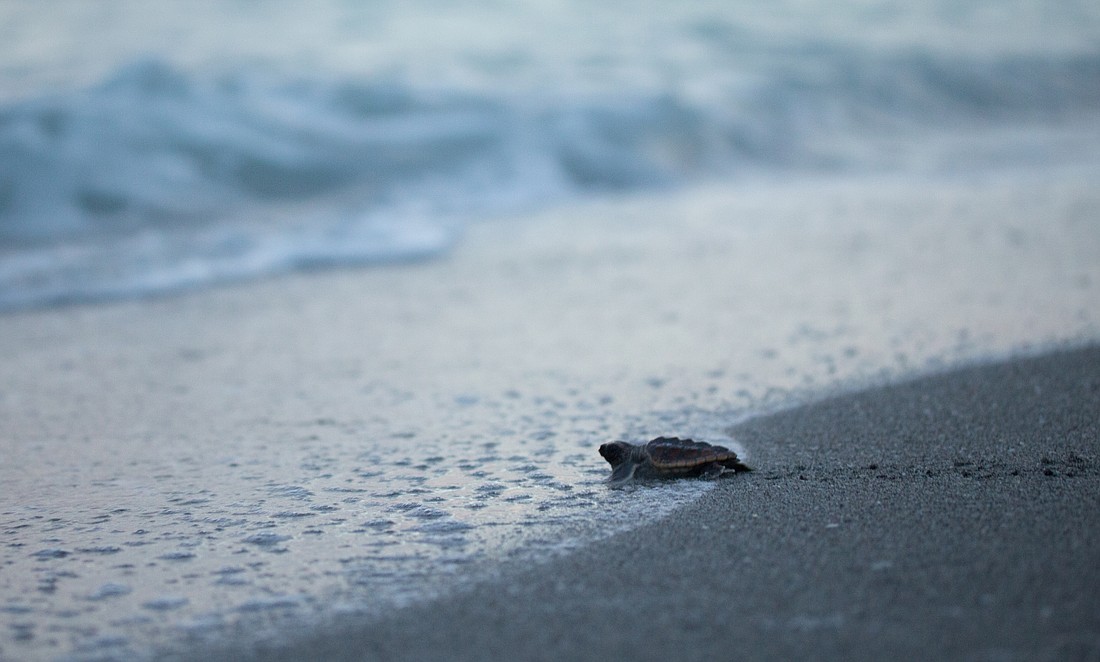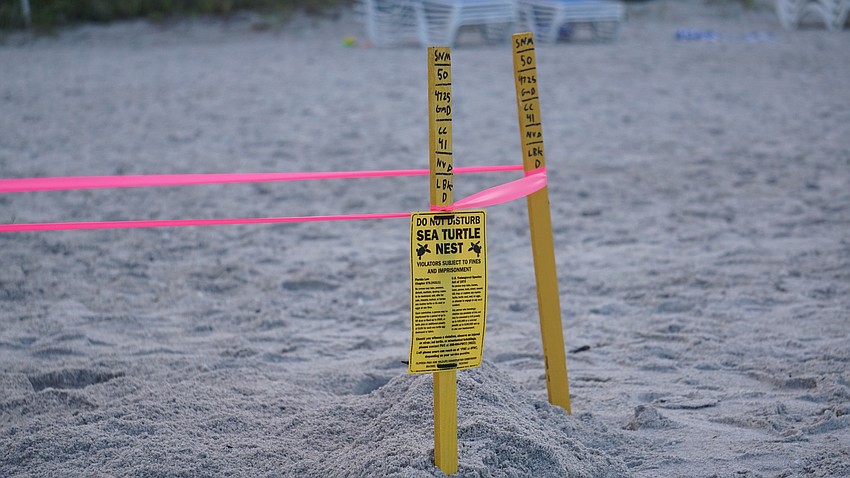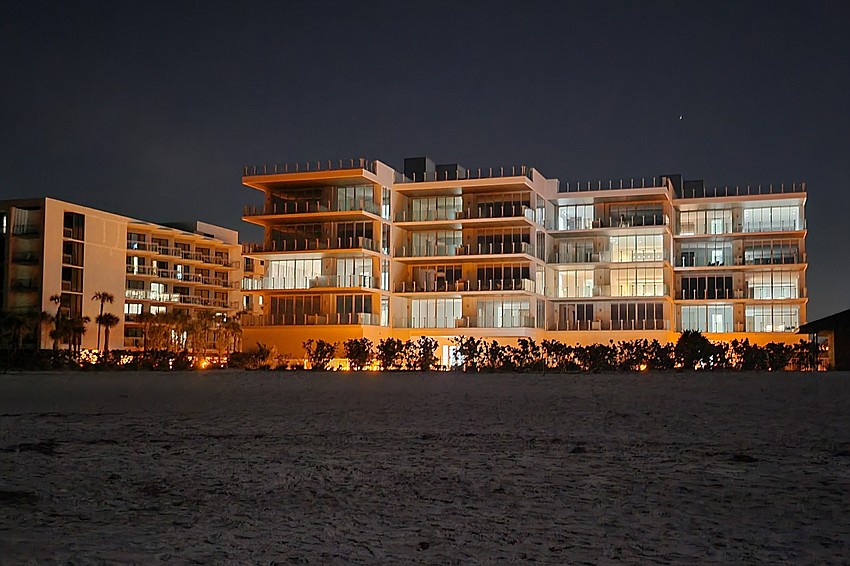- October 23, 2024
-
-
Loading

Loading

This year’s sea turtle nesting season from Longboat Key to Venice saw the fifth highest number of nests in Mote Marine Laboratory & Aquarium’s more than 40-year program history.
It was also the highest recorded nesting season for green turtles, at just under 200 nests. The number of loggerhead nests was just under 2,000.
On Longboat Key, the nesting season was off to a strong and early start, with 307 nests in the first month of the 2023 season. During the 2021 season, there were 165 nests in the first month.
At the end of the season, which runs until Oct. 31, Mote’s total number of nests was 4,091 loggerhead nests and 193 green turtle nests.
Of those, 978 loggerhead and 12 green turtle nests were on Longboat Key.
Lido Key had a total of 184 loggerhead nests but had no green turtle nests. Siesta Key, though, had 7 green turtle nests and 364 loggerhead nests.
Mote Senior Biologist & Conservation Manager Melissa Macksey said the 2023 season ended very positively. The biggest win of the season, she said, was the number of green sea turtle nests, and the fact that those continue to grow exponentially over the years.
There’s not a lot to be gravely concerned about, she said, but there were some key takeaways from the season.

Though Macksey hasn’t yet officially wrapped up data analysis for the season, she did say that it appears the hatch success was a little lower this year.
The cause of this, she hypothesized, are more frequent lethal temperatures. This summer’s extreme heat impacted water temperatures, but also may have caused a lower success rate for the turtles.
Another problem continues to be a problem in all areas are disorientation rates.
“This year there were a lot of disorientations,” Macksey said. “I don’t know that it was the highest year ever, but it was pretty close.”
Disorientations of sea turtles occur when artificial light causes nesting mothers or hatchlings to become confused and go off course.
The results of disorientations are turtles that often end up in pools, hot tubs or become food for predators like raccoons, said Macksey.
These events happen more frequently on beaches with a lot of resorts, like North Siesta and North Venice.
Longboat Key has one of the highest disorientation rates in the state, according to Macksey.
“It’s not a great ranking to be in,” Macksey said.
Macksey was unable to share disorientation rates for the 2023 season since numbers are still in the process of being verified, but she said this year was not too different from the 2022 season.
In 2022, Longboat Key had a total of 1,294 nests. Of those, 262 were disoriented, leading to a disorientation rate of 20.2%.
Another way to look at the rate, Macksey said, is to look at a subset of just hatched nests. The total number of nests can be a confusing comparison, because some of those nests may not have hatched.
A subset of 240 hatched nests in the 2022 season had 68 disorientations, which produces a disorientation rate of 28.3%.
Therefore, in the 2022 season Macksey would say the rate was anywhere from 20 to 30%.
“Twenty percent is when red flags start to get raised,” Macksey said.
An area that Mote usually compares Longboat Key to is Casey Key. There, nesting density is a little higher, but in terms of lighting it’s a similar atmosphere to Longboat.
Last year, Casey Key had a 1% disorientation rate.
While this year’s disorientation rates didn’t break records, Macksey said they were pretty close. Perhaps the only reason they didn’t, she suggested, was because Hurricane Idalia’s storm surge wiped out many of the nests for the remainder of the season.
Disorientation rates are usually able to be tracked back to a specific nest, and most of the time it’s the hatchlings that are more impacted by the light, according to Macksey.
Longboat Key Turtle Watch Vice President Cyndi Seamon said it might be due to hatchlings getting more distracted by the lights than older, adult females.
“And so if you have a female that’s roaming around the wrong way, that’s a pretty bright light,” Seamon said.
“A beach like Longboat Key is a ‘perfect storm’ for sea turtles,” Macksey said. It’s an ideal nesting spot that also presents many lighting obstacles.
But because Longboat Key has a good chunk of total sea turtle nests — 990 out of 4,284 this year — Macksey said the program tries to emphasize working closely with town code enforcement.
Going forward, Macksey and Seamon both agree that education and awareness about the impacts of artificial light are key.
On Longboat Key, town codes require that lights visible from the beach utilize turtle-safe lights, and that one or more other measures are taken to reduce light emanating from windows or doors. Those measures include: turning off unnecessary lights, using blinds or curtains, rearranging movable fixtures and/or applying window tint.
“We try to just encourage people, regardless of what your code is, if you have a light that’s visible from the beach, just try to make it turtle-friendly or turn it off,” Macksey said.
Because humans aren’t impacted by light the same way as many other animals, Macksey said some people may not realize that adhering to these ordinances can go a long way.
“I think a lot of it, too, is that people don’t realize that it’s a problem, or that it doesn’t make sense because we aren’t impacted by light in the way turtles are.”
While the town codes can help on the surface level, there are other implications that may not be as obvious.
Macksey said there’s a problem with non-beachfront lights across narrow waterways. For example, a nest hatching on the south end of Longboat Key may be disoriented by houses on the north end of Lido Key that don’t have beaches.

Seamon, who patrols the beaches with Longboat Key Turtle Watch and corresponds with town code enforcement, said resorts with lights continue to be a problem on Longboat Key.
Newer buildings need to meet the window tint compliance, Seamon said, but even then the bright LED lights are shining through the windows of resorts.
“If you don’t have drapes to pull them, (the light) is just blasting,” Seamon said.
And as buildings, dunes and other structures change over time on beachfront properties, this could also lead to light shining through from major roads or even the bay side.
Turnover is also a problem for educational efforts. Code enforcement officers, when hired, need to be up-to-date, and new renters during turtle season may be unaware of the lighting implications.
That’s why continued education and collaboration with code enforcement is important to both Macksey and Seamon.
“We’re really wanting to urge people that live on the beach or have any input in beachfront lighting to really try to keep that down, especially during turtle season,” Macksey said.